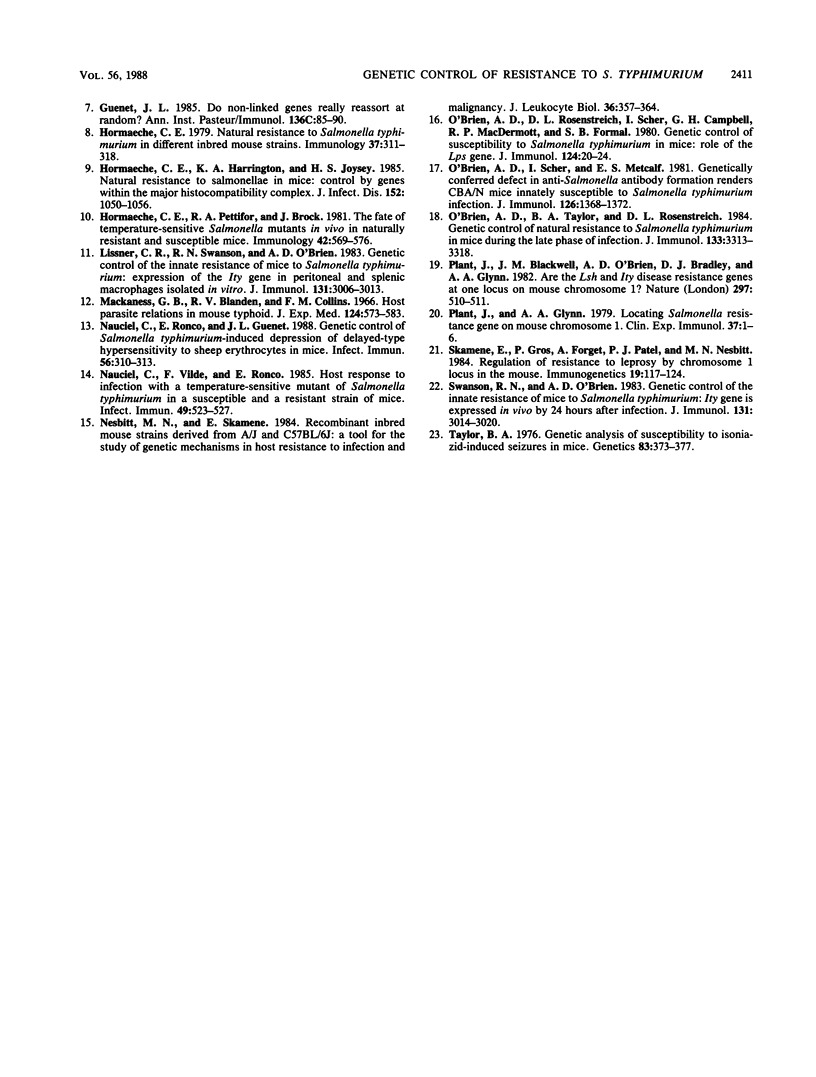Abstract
The ability of mice to clear Salmonella typhimurium from their spleens in the late phase of infection was studied after inoculation with a temperature-sensitive mutant. Clearance of bacteria was delayed in C57BL/6 mice compared with BALB/c, C3H/HeJ, DBA/2, A/J, and CBA mice. The responses of F1 hybrids, backcrosses, and recombinant inbred strains derived from C57BL/6 and BALB/c (both Itys) and of H-2 congenic mice were analyzed. The results showed that the low rate of bacterial clearance was recessive, that the rate of clearance was under polygenic control, and that an H-2-linked gene(s) plays a major role. Among H-2 congenic mice with a C57BL/10 background, three phenotypes of bacterial clearance could be distinguished: high (H-2j, H-2q, and H-2u), intermediate (H-2d, H-2f, H-2k, H-2p, H-2r, H-2s, and H-2v), and low (H-2b) rates. The effect of the H-2 complex was apparent with different genetic backgrounds (Itys and Ityr). In recombinant inbred strains derived from C57BL/6 (Itys) and A/J (Ityr) mice, the effect of the H-2b haplotype on bacterial clearance appeared to be fully expressed only in strains carrying the Itys allele.
Full text
PDF




Selected References
These references are in PubMed. This may not be the complete list of references from this article.
- Benjamin W. H., Jr, Turnbough C. L., Jr, Posey B. S., Briles D. E. Salmonella typhimurium virulence genes necessary to exploit the Itys/s genotype of the mouse. Infect Immun. 1986 Mar;51(3):872–878. doi: 10.1128/iai.51.3.872-878.1986. [DOI] [PMC free article] [PubMed] [Google Scholar]
- Blackwell J., Freeman J., Bradley D. Influence of H-2 complex on acquired resistance to Leishmania donovani infection in mice. Nature. 1980 Jan 3;283(5742):72–74. doi: 10.1038/283072a0. [DOI] [PubMed] [Google Scholar]
- Brown I. N., Glynn A. A., Plant J. Inbred mouse strain resistance to Mycobacterium lepraemurium follows the Ity/Lsh pattern. Immunology. 1982 Sep;47(1):149–156. [PMC free article] [PubMed] [Google Scholar]
- Curtis J., Adu H. O., Turk J. L. H-2 linkage control of resistance to subcutaneous infection with Mycobacterium lepraemurium. Infect Immun. 1982 Nov;38(2):434–439. doi: 10.1128/iai.38.2.434-439.1982. [DOI] [PMC free article] [PubMed] [Google Scholar]
- Deschenes M., Guenounou M., Ronco E., Vacheron F., Nauciel C. Impairment of lymphocyte proliferative responses and interleukin-2 production in susceptible (C57BL/6) mice infected with Salmonella typhimurium. Immunology. 1986 Jun;58(2):225–230. [PMC free article] [PubMed] [Google Scholar]
- Guénet J. L. Do non-linked genes really reassort at random? Ann Inst Pasteur Immunol. 1985 Jan-Feb;136C(1):85–90. [PubMed] [Google Scholar]
- Hormaeche C. E., Harrington K. A., Joysey H. S. Natural resistance to salmonellae in mice: control by genes within the major histocompatibility complex. J Infect Dis. 1985 Nov;152(5):1050–1056. doi: 10.1093/infdis/152.5.1050. [DOI] [PubMed] [Google Scholar]
- Hormaeche C. E. Natural resistance to Salmonella typhimurium in different inbred mouse strains. Immunology. 1979 Jun;37(2):311–318. [PMC free article] [PubMed] [Google Scholar]
- Hormaeche C. E., Pettifor R. A., Brock J. The fate of temperature-sensitive salmonella mutants in vivo in naturally resistant and susceptible mice. Immunology. 1981 Apr;42(4):569–576. [PMC free article] [PubMed] [Google Scholar]
- Lissner C. R., Swanson R. N., O'Brien A. D. Genetic control of the innate resistance of mice to Salmonella typhimurium: expression of the Ity gene in peritoneal and splenic macrophages isolated in vitro. J Immunol. 1983 Dec;131(6):3006–3013. [PubMed] [Google Scholar]
- Mackaness G. B., Blanden R. V., Collins F. M. Host-parasite relations in mouse typhoid. J Exp Med. 1966 Oct 1;124(4):573–583. doi: 10.1084/jem.124.4.573. [DOI] [PMC free article] [PubMed] [Google Scholar]
- Nauciel C., Ronco E., Guenet J. L. Genetic control of Salmonella typhimurium-induced depression of delayed-type hypersensitivity to sheep erythrocytes in mice. Infect Immun. 1988 Feb;56(2):310–313. doi: 10.1128/iai.56.2.310-313.1988. [DOI] [PMC free article] [PubMed] [Google Scholar]
- Nauciel C., Vilde F., Ronco E. Host response to infection with a temperature-sensitive mutant of Salmonella typhimurium in a susceptible and a resistant strain of mice. Infect Immun. 1985 Sep;49(3):523–527. doi: 10.1128/iai.49.3.523-527.1985. [DOI] [PMC free article] [PubMed] [Google Scholar]
- Nesbitt M. N., Skamene E. Recombinant inbred mouse strains derived from A/J and C57BL/6J: a tool for the study of genetic mechanisms in host resistance to infection and malignancy. J Leukoc Biol. 1984 Sep;36(3):357–364. doi: 10.1002/jlb.36.3.357. [DOI] [PubMed] [Google Scholar]
- O'Brien A. D., Rosenstreich D. L., Scher I., Campbell G. H., MacDermott R. P., Formal S. B. Genetic control of susceptibility to Salmonella typhimurium in mice: role of the LPS gene. J Immunol. 1980 Jan;124(1):20–24. [PubMed] [Google Scholar]
- O'Brien A. D., Scher I., Metcalf E. S. Genetically conferred defect in anti-Salmonella antibody formation renders CBA/N mice innately susceptible to Salmonella typhimurium infection. J Immunol. 1981 Apr;126(4):1368–1372. [PubMed] [Google Scholar]
- O'Brien A. D., Taylor B. A., Rosenstreich D. L. Genetic control of natural resistance to Salmonella typhimurium in mice during the late phase of infection. J Immunol. 1984 Dec;133(6):3313–3318. [PubMed] [Google Scholar]
- Plant J. E., Blackwell J. M., O'Brien A. D., Bradley D. J., Glynn A. A. Are the Lsh and Ity disease resistance genes at one locus on mouse chromosome 1? Nature. 1982 Jun 10;297(5866):510–511. doi: 10.1038/297510a0. [DOI] [PubMed] [Google Scholar]
- Plant J., Glynn A. A. Locating salmonella resistance gene on mouse chromosome 1. Clin Exp Immunol. 1979 Jul;37(1):1–6. [PMC free article] [PubMed] [Google Scholar]
- Skamene E., Gros P., Forget A., Patel P. J., Nesbitt M. N. Regulation of resistance to leprosy by chromosome 1 locus in the mouse. Immunogenetics. 1984;19(2):117–124. doi: 10.1007/BF00387854. [DOI] [PubMed] [Google Scholar]
- Swanson R. N., O'Brien A. D. Genetic control of the innate resistance of mice to Salmonella typhimurium: Ity gene is expressed in vivo by 24 hours after infection. J Immunol. 1983 Dec;131(6):3014–3020. [PubMed] [Google Scholar]
- Taylor B. A. Genetic analysis of susceptibility to isoniazid-induced seizures in mice. Genetics. 1976 Jun;83(2):373–377. doi: 10.1093/genetics/83.2.373. [DOI] [PMC free article] [PubMed] [Google Scholar]


